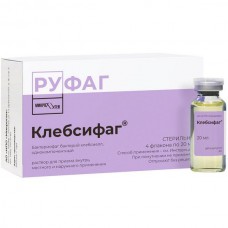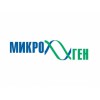Expiration date: 02/2027
Composition
1 ml of the drug contains:
Active substance.
Sterile purified filtrate of phagolysates of bacteria Klebsiella pneumoniae, Klebsiella ozaenae, Klebsiella rhinoscleromatis (with an activity according to Appelman of at least 10-4) - up to 1 ml.
Auxiliary substance.
8-hydroxyquinoline sulfate monohydrate (preservative) in terms of 8-hydroxyquinoline sulfate - 0.0001 g (calculated content).
Packaging and release form
Solution for oral, topical and external use in 20 ml vials - 4 pcs with instructions for use in the package.
Dosage form
Transparent yellow liquid of varying degrees of intensity, a greenish tinge is allowed.
Pharmacodynamics
The drug causes specific lysis of the bacteria Klebsiella pneumoniae, Klebsiella ozaenae, Klebsiella rhinoscleromatis.
Indications
Treatment and prevention of diseases caused by the bacteria Klebsiella pneumoniae, Klebsiella ozaenae, Klebsiella rhinoscleromatis as part of complex therapy:
- ozen, scleroma;
- diseases of the gastrointestinal tract (gastroenterocolitis, cholecystitis, pancreatitis, intestinal dysbiosis);
- inflammatory diseases of newborns and young children (gastroenterocolitis, intestinal dysbiosis, omphalitis, pemphigus, pyoderma, septicemia and septicopyemia of various localization);
- surgical infections (suppuration of wounds, purulent skin lesions, burns, peritonitis, pleurisy, mastitis, osteomyelitis, abscess);
- urogenital infections (cystitis, pyelonephritis, urethritis, endometritis, vulvitis, bartholinitis, colpitis, salpingoophoritis);
- purulent-inflammatory diseases of the ear, throat, nose, sinuses, mouth, pharynx, larynx, bronchi, lungs and pleura (otitis media, sore throat, pharyngitis, laryngitis, stomatitis, periodontitis, sinusitis, frontitis, bronchitis, pneumonia, pleurisy);
- post-traumatic conjunctivitis, keratoconjunctivitis, purulent corneal ulcer and iridocyclitis;
- prevention of nosocomial infections caused by Klebsiella.
Contraindications
Hypersensitivity to the components of the drug.
Use during pregnancy and lactation.
The use of this drug during pregnancy and lactation is possible in the presence of infections caused by phage-sensitive strains of Klebsiella (on the recommendation of a doctor).
The method of administration and dosage
The drug is used for oral administration, in the form of enemas, applications, irrigation, injection into the cavities of wounds, vagina, uterus, nose, sinuses, as well as into drained cavities: abscesses, abdominal, pleural, bladder, renal pelvis.
Inside, the drug is taken on an empty stomach 0.5-1 hour before meals.
RECOMMENDED DOSAGES OF THE DRUG
PATIENT'S AGE DOSE PER 1 DOSE
with various methods
of oral administration (ml) in an enema (ml)
0-6 months 5-10
6-12 months 10 20
From 1 year to 3 years 15 20-30
From 3 to 8 years old 20-40
From 8 years and older 20-30 40-50
Treatment of purulent-inflammatory diseases with localized lesions should be carried out simultaneously both topically and by taking the drug orally.
In the case of treatment of the purulent cavity with chemical antiseptics, it should be washed with a sterile 0.9% sodium chloride solution before using the bacteriophage.
In the treatment of ozena and scleroma, the drug is used to wash the nasal cavity and the mucous membrane of the upper respiratory tract, for administration into the sinuses (according to clinical indications), as well as for damage to the pharynx, larynx, trachea in the form of inhalations (without heating and using ultrasound). The dose of the drug for the treatment of nasal and upper respiratory tract mucosa is 10-20 ml. After rinsing the mucous membranes into the nasal cavity, turunds soaked with the drug are injected into each nasal passage in turn and left for 1 hour. The procedure is repeated 2-3 times a day for 20-40 days. Since ozen and scleroma are chronic diseases, it is recommended to carry out 20-40 day treatment courses once a year according to the above scheme in order to prevent exacerbations.
In the treatment of sore throats, pharyngitis, laryngitis, the drug is used to rinse the mouth and pharynx 3 times a day for 10-20 ml, the course of treatment is 7-10 days.
In the treatment of bronchitis, pneumonia, the drug is taken orally 3 times a day for
10-20 ml, and also used in the form of aerosols and inhalations (without heating and using ultrasound), the course of treatment is 15-20 days.
In the treatment of otitis media, the drug is used to wash and inject into the middle ear cavity 2-5 ml 1-3 times a day. The course of treatment is 7-15 days.
In the treatment of inflammation of the sinuses, the drug is used to wash the nasal cavity, nasopharynx and sinuses in a dose of 5-10 ml and inject 2-3 ml into the sinuses. The procedure is repeated daily once for 7-10 days. In addition, the drug is injected into the nasal cavity in the form of turundas moistened with bacteriophage, one at a time into each nasal passage and left for 0.5-1 hour. The procedure is repeated 3 times a day, the course of treatment is 7-15 days.
In the treatment of stomatitis and chronic periodontitis, the drug is used as mouthwashes 3-4 times a day at a dose of 10-20 ml, as well as by injecting turundum impregnated with Klebsiella bacteriophage into periodontal pockets for 5-10 minutes, the course of treatment is 7-10 days.
For conjunctivitis and keratoconjunctivitis, the drug is used 2-3 drops 4-5 times a day, the course of treatment is 5-7 days; for purulent corneal ulcer - 4-5 drops per day for 7-10 days; for purulent iridocyclitis - 6-8 drops every 3 hours in combination with oral administration in therapeutic dosages for 7-10 days.
In case of abscesses, after opening and removing the purulent contents, the drug is administered in an amount less than the volume of the removed pus daily once, the course of treatment is 7-10 days.
In case of peritonitis and pleurisy, the drug is injected into the drained cavities - abdominal and pleural through drainage tubes daily once 20-70 ml, the course of treatment is 10-15 days.
In osteomyelitis, the drug is injected into the wound cavity through turundae, drains in an amount of 10-30 ml daily once, the course of treatment is 15-20 days.
In the treatment of wound suppuration, the drug is used in the form of irrigation, applications, bandages, and injection into drainage at a dose of 5-50 ml, depending on the lesion, at least once a day, and the course of treatment is 10-15 days.
In the treatment of purulent-inflammatory gynecological diseases (suppuration of wounds, endometritis, vulvitis, bartholinitis, colpitis, salpingoophoritis), the drug is used for irrigation, applications, injected into the cavities of wounds, vaginas, uterus 5-20 ml once a day for 7-10 days.
For cystitis, pyelonephritis, and urethritis, the drug is taken orally at a therapeutic dose 3 times a day 1 hour before meals for 10-20 days. In the event that the cavity of the bladder or renal pelvis is drained, the drug is administered through a cystostomy or nephrostomy 1-3 times a day, 20-50 ml into the bladder and 5-7 ml into the renal pelvis, the course of treatment is 7-15 days.
For gastroenterocolitis, pancreatitis, cholecystitis, and intestinal dysbiosis, the bacteriophage is taken orally in age-appropriate dosages 3 times a day 1 hour before meals for 7-15 days (according to clinical indications). In case of uncontrollable vomiting, the drug is used in the form of high enemas 2-3 times a day for 20-40 ml. In case of intestinal dysbiosis, the drug can be used with normoflora preparations.
For the prevention of nosocomial surgical infections, the drug is used to treat postoperative and freshly infected wounds in a dose of 5-50 ml, depending on the lesion, once daily for 5-7 days.
Use of the drug in children under 1 year of age (including premature infants).
For gastroenterocolitis, pneumonia and sepsis of newborns, the drug is administered by mouth 2-3 times a day, 3-5 ml 30 minutes before feeding. In cases of uncontrollable vomiting, the drug is used in the form of high enemas (through a gas outlet tube or catheter) daily once in a dose of 5-10 ml. A combination of rectal (in the form of high enemas) and oral administration of the drug is possible. The course of treatment is 7-15 days (according to clinical indications). With a recurrent course of the disease, repeated treatment is possible.
In order to prevent the occurrence of nosocomial infection in newborns, bacteriophage is used orally for 3-5 ml 3 times a day for 30 minutes before feeding during the entire hospital stay.
In the treatment of omphalitis, pyoderma, and infected wounds, bacteriophage is applied in the form of applications of 5-10 ml 2-3 times a day (a gauze cloth is moistened with bacteriophage and applied to the umbilical wound or the affected area of the skin) for 7-15 days.
The use of the drug does not exclude the use of other antibacterial and anti-inflammatory drugs.
If there is no improvement after treatment, or the symptoms worsen, or new symptoms appear, it is necessary to consult a doctor. Use the drug only according to the indications, the method of use and in the doses specified in the instructions.
Special instructions
An important condition for effective phage therapy is the preliminary determination of the sensitivity of the pathogen to the bacteriophage.
The bacteriophage vial must be shaken and examined before use. The preparation must be transparent and free of sediment.
Attention! In case of turbidity, do not use the drug!
Due to the nutrient medium in the preparation, in which bacteria from the environment can develop, causing turbidity of the preparation, it is necessary to observe the following rules when opening the vial:
- - wash your hands thoroughly;
- - treat the cap with an alcohol-containing solution;
- - remove the cap without opening the stopper;
- - do not place the stopper inside on a table or other objects.;
- - do not leave the bottle open;
- - keep the opened bottle only in the refrigerator.
When using small doses (2-8 drops), the drug must be taken with a sterile syringe in a volume of 0.5-1 ml.
The drug from the opened bottle, subject to the storage conditions, the above rules and the absence of turbidity, can be used throughout the shelf life.
Influence on the ability to drive vehicles and mechanisms. The drug does not affect the ability to drive vehicles or engage in other potentially dangerous activities that require increased concentration and speed of psychomotor reactions.
Side effects
Not installed.
Drug interaction
The drug can be used in combination with other medications, including antibiotics.
Storage temperature
from 2℃ to 8℃
Overdose
No overdose cases have been reported.
Special storage conditions
Transportation conditions. At temperatures from 2 to 8 ° C, transportation is allowed at temperatures from 9 to 25 ° C for no more than 1 month.
Storage conditions. At a temperature of 2 to 8 ° C in a place protected from light.


